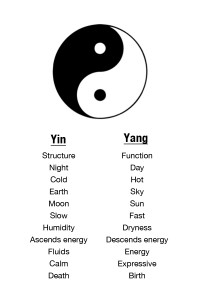
The Theory of Yin and Yang is one such philosophy. The concept of Yin Yang is that the only constant in the universe is change. Nothing can stay in a certain state permanently. No emotion, no disease, no planet, no sun… nothing! Everything is a part of this grand cycle and there are no exceptions.
Yin and Yang are metaphors to help understand these constant changes. They have no fixed, precise definition. They are two complimentary concepts that help to give balance to one another and keep each other in a state of harmony. Some examples are positive and negative, dynamic and inert, creative and destructive and Intense and subtle. This can be understood in from a mathematical perspective quite easily. A sum is never separate from its parts. They are one in the same. As these various parts interact they become their opposites.
The entire universe may be viewed as the communication and interplay of yin and yang. Originally the Chinese characters for yin represented the moon and yang represented the sun. Eventually these terms came to include yin as night and yang as day, yin as winter and yang as summer, and yin as female and yang as male. In reality, everything is within the interplay of yin and yang.
Yin is steadfast and endures. It nourishes and creates growth and provides the structure for growth. It is the cold. It is the fluid. It is the substance as opposed to the action. It is the mass as opposed to the inertia.
Yang is force and movement. It is expansion as opposed to contraction. It is laughter and joy as opposed to sadness and depression. It is dynamic and changing.
Yin and Yang are not static. They are constantly in flux. There is always the seed of Yin within Yang and vice versa. For example: The shady side of a mountain during the day is yin (darker and colder). The concept of daytime is yang, because it is bright and hot. We would call the shady side of the mountain “yin within yang” because it is a yin element during a yang time. Conversely, the opposite holds true at night. Night is considered a yin time (dark and cool). The moonlit side of the mountain is considered yang (brighter and warmer). We would call this “yang within yin.”
This concept becomes very important when looking at the field of Chinese Medicine. Chinese medicine doesn’t concern itself with a formal diagnosis as much as it does whether or not the disease process is more of a Yin dominant one or a Yang dominant one. For example: If a patient presents with feelings of heaviness, excessive weight gain, lethargy and swelling around the ankles, at first glance this is a Yin dominant condition. If a patient presents with rapid heart rate, feelings of heat, excess perspiration, racing thoughts and a thin frame, at first glance this is a Yang dominant condition.
As previously mentioned this can become more complex because Yin never exists without the seed of Yang and vice versa. A patient may present with Yin dominant symptoms but also have a rapid heart rate and fever. (Yang within Yin) In the clinical setting this tends to happen more times than not.
Yin and Yang are the universal movement of everything and act as a forum through which movement can take place, not only physical movement but energetic and ethereal movement too. It is all part of the grand interplay of Yin and Yang. We are all part of it and we are selves are made up of it. The goal is to keep the Yin and Yang energies in a harmonious state to live a long healthy life. Chinese Medicine is a fantastic tool to help this happen. It is the instrument of change and the tool of balance!
As always, feel free to call or email if you have any questions or need clarification!

